Realization and Prediction of Ecological Restoration Potential of Vegetation in Karst Areas
Abstract
:1. Introduction
2. Data and Methods
2.1. Overview of the Study Area
2.2. Data and Processing
2.2.1. Geographic Information
2.2.2. Meteorological Data
2.2.3. Soil Types
2.2.4. Vegetation Types
2.2.5. Vegetation Ecological Parameters
2.3. Data Analysis
2.3.1. Vegetation Ecological Quality Index
2.3.2. Analysis Method of the Influencing Factors of Ecological Restoration of Vegetation
2.3.3. Calculation Method for the Maximum Ecological Restoration Potential of the Vegetation
2.3.4. Realization and Prediction Models of Ecological Restoration Potential of Vegetation
3. Results
3.1. Status of Ecological Restoration of Vegetation in the Karst Areas of Guangxi
3.2. Influencing Factors of Ecological Restoration of Vegetation in the Karst Areas of Guangxi
3.2.1. Impact of Terrain on Ecological Restoration of Vegetation
3.2.2. Impact of Soil on Ecological Restoration of Vegetation
3.2.3. Impact of Vegetation Types on Ecological Restoration of Vegetation
3.2.4. Impact of Climate on Ecological Restoration of Vegetation
3.2.5. Zoning of Comprehensive Influencing Factors of Ecological Restoration of Vegetation
3.3. Realization and Prediction Evaluation of Ecological Restoration Potential of the Vegetation in the Karst Areas of Guangxi
3.3.1. Estimation of the Maximum Ecological Restoration Potential of Vegetation
3.3.2. Evaluation of Realization Degree of Ecological Restoration Potential of the Vegetation
3.3.3. Prediction of Ecological Restoration Potential of Vegetation
4. Discussion
5. Conclusions
- (1)
- In the karst areas of Guangxi, the level of the vegetation ecological quality was high from 2000 to 2019, with a fluctuating increasing trend.
- (2)
- The terrain, soil, vegetation type, and climatic conditions had a significant impact on the vegetation ecological restoration in the study area. With the increase in the soil sand content, the change in the vegetation ecological quality index was more significant at altitudes of 200–800 m and slopes of 15°–35°. The maximum of the forest ecological restoration potential was the highest. The precipitation was the most significant area of vegetation ecological restoration affected by climate.
- (3)
- The realization level of the ecological restoration potential of the vegetation was relatively high, and the implementation effect of ecological restoration projects was good, with a vegetation ecological quality index of 97.95% in the areas that were restored.
- (4)
- In the future, the ecological restoration potential of the vegetation in the karst areas of Guangxi is predicted to be mainly low (distributed in the north and southeast of Hechi, the northwest of Baise, and the west of Chongzuo) and medium (distributed in the south of Hechi, the south of Baise, and the north of Chongzuo).
Author Contributions
Funding
Institutional Review Board Statement
Informed Consent Statement
Data Availability Statement
Conflicts of Interest
References
- Sun, S. Afforestation, 2nd ed.; China Forestry Press: Beijing, China, 1996; p. 224. [Google Scholar]
- Zhu, S.; He, J.; Zhu, X. An evaluation and dividing area on degree of planting difficulty in Karst region of Wujiang Watershed. J. Mt. Agric. Biol. 1998, 17, 129–134. [Google Scholar]
- Zhou, Y.; He, X.; Xie, Y.; Wang, M.; Wu, M.; Wu, D. Type classification for vegetation restoration of karst mountains in Bijie. Sci. Silvae Sin. 2008, 44, 123–128. [Google Scholar]
- Zhang, Z. Assessment of Soil Organic Carbon Distribution, Storage and Vegetation Restoration Potential in Karst Rocky Desertification; Guizhou University: Guizhou, China, 2017. [Google Scholar]
- Wang, Y.; Wang, K.L.; Zhou, D.S.; Li, L.; Chen, Z.H. Effects of vegetation succession on soil quality in karst region of Guangxi, China. J. Soil Water Conserv. 2007, 21, 130–134. [Google Scholar]
- Wang, M.C.; Zhang, X.C.; Li, H.J.; Zhou, H.Y.; Wei, X.H.; Guan, G.C. An analysis of soil quality changes in the process of ecological restoration in karst rocky desertification area:A case study in karst ecological restoration and rehabilitation region of Guzhou Village. Ecol. Environ. Sci. 2016, 25, 947–955. [Google Scholar]
- Yu, L.; Zhu, S.; Ye, J.; Wei, L.; Chen, Z. A study on evaluation of natural restoration for degraded karst forest. For. Sci. 2000, 36, 12–19. [Google Scholar]
- Zhu, S.; Chen, Z.; Wei, L. The process and pattern of natural restoration in degraded Karst forest. J. Guizhou Univ. Agric. Biol. Sci. Ed. 2002, 21, 19–25. [Google Scholar]
- Xu, X.; Yang, D.; Hu, T. Study on the adaptability of different plant species in the vegetation restoration of highway slopes. Highway 2004, 6, 157–161. [Google Scholar]
- Tang, Y.; Xie, Y.; Yu, G. Assessment of restoration potential of degraded karst vegetation in north-western of Guizhou, SW China. J. Mt. Sci. 2012, 30, 528–534. [Google Scholar]
- Xiang, Z. Distribution of Biomass and Nutrient Elements in Different Vegetation Restoration Models in the Rocky Desertification Area of Shaoyang County; Central South University of Forestry and Technology: Changsha, China, 2010. [Google Scholar]
- Tobler, W. A computer movie simulating urban growth in the Detroit region. Econ. Geogr. 1970, 46, 234–240. [Google Scholar] [CrossRef]
- Zhang, D.; Jia, Q.; Wang, P.; Zhang, J.; Hou, X.; Li, X.; Li, W. Analysis of spatial variability in factors contributing to vegetation restoration in Yan’an, China. Ecol. Indic. 2020, 113, 106–278. [Google Scholar] [CrossRef]
- Gao, H.; Pang, G.; Li, Z. Evaluating the potential of vegetation restoration in the Loess Plateau. Acta Geogr. Sin. 2017, 72, 863–874. [Google Scholar]
- Zhao, G.; Mu, X.; Tian, P. Prediction of vegetation variation and vegetation restoration potential in the loess plateau. J. Soil Water Conserv. 2021, 35, 205–212. [Google Scholar]
- Qian, S.; Yan, H.; Wu, M.X. Dynamic monitoring and evaluation model for spatio-temporal change of comprehensive ecological quality of vegetation. Acta Ecol. Sin. 2020, 40, 6573–6583. [Google Scholar]
- Ji, Y.H.; Zhou, G.S.; Wang, S.D.; Wang, L.X.; Zhou, M.Z. Evolution characteristics and its driving forces analysis of vegetation ecological quality in Qinling Mountains region from 2000 to 2019. Chin. J. Plant Ecol. 2021, 45, 617–625. [Google Scholar] [CrossRef]
- Sun, J. Principles and Applications of Remote Sensing; Wuhan University Press: Wuhan, China, 2003. [Google Scholar]
- Su, W.; Gan, S.; Yuan, X. Changes of vegetation coverage and its driving factors in Simao Basin in recent 30 years. J. Henan Univ. Nat. Sci. 2018, 48, 574–580. [Google Scholar]
- Yan, H.; Wang, S.Q.; Billesbach, D.; Oechel, W.; Bohrer, G.; Meyers, T.; Martin, T.A.; Matamala, R.; Phillips, R.P.; Rahman, F.; et al. Improved global simulations of gross primary product based on a new definition of water stress factor and a separate treatment of C3 and C4 plants. Ecol. Model. 2015, 297, 42–59. [Google Scholar] [CrossRef]
- Brewer, J.S.; Menzel, T. A method for evaluating outcomes of restoration when no references sites exist. Restor. Ecol. 2009, 17, 4–11. [Google Scholar] [CrossRef]
- Jiang, J.; Gao, D.Z.; DeAngelis, D.L. Towards a theory of ecotone resilience: Coastal vegetation on a salinity gradient. Theor. Popul. Biol. 2012, 82, 29–37. [Google Scholar] [CrossRef]
- Laughlin, D.C. Applying trait-based models to achieve functional targets for theory-driven ecological restoration. Ecol. Lett. 2014, 17, 771–784. [Google Scholar] [CrossRef]
- Mu, S.J.; Li, J.L.; Chen, Y.Z.; Gang, C.; Zhou, W.; Ju, W.M. Spatial differences of variations of vegetation coverage in Inner Mongolia during 2001–2010. Acta Geogr. Sin. 2012, 67, 1255–1268. [Google Scholar]
- Cao, L. Dynamic Changes of Vegetation NDVI in Jiangsu Province and Its Relationship with Climatic Factors; Nanjing Agricultural University: Nanjing, China, 2014. [Google Scholar]
- National Technical Committee of Agricultural Meteorology Standardization. Grade of Monitoring and Evaluating for Terrestrial Vegetation Meteorology and Ecological Quality: QX/T 494-2019; China Standard Press: Beijing, China, 2019. [Google Scholar]
- Chen, Y.; Meng, L.; Huang, X. Temporal and Spatial Distributions of Drought in Guangxi Karst Area During 1971–2017 Based on Standardized Precipitation Evapotranspiration Index. J. Arid. Meteorol. 2019, 37, 353–362. [Google Scholar]
- Wang, Z.; Yan, H.; Mo, M. Do a Good Job in Post- disaster Assessment Survey Scientific Organizations Reconstruction—Research Report on Forestry Restoration after Guangxi Zhuang Nature Reserve Disaster. For. Econ. 2008, 4, 21–24. [Google Scholar]
- Mao, L.; Li, C.; Hou, Y. China meteorologically-driven ecological monitoring and assessment in the first half of 2006. Meteorol. Mon. 2006, 32, 88–95. [Google Scholar]
- Qian, S.; Mao, L.; Hou, Y. Technology and application of ecology meteorological synthetic monitoring and predicting for northern grassland in China. Meteorol. Mon. 2008, 34, 62–68. [Google Scholar]
- Yuan, F.; Bauer, M.E. Comparison of impervious surface area and normalized difference vegetation index as indicators of surface urban heat island effects in Landsat imagery. Remote Sens. Environ. 2007, 106, 375–386. [Google Scholar] [CrossRef]
- Wright, C.K.; De Beurs, K.M.; Henebry, G.M. Combined analysis of land cover change and NDVI trends in the Northern Eurasian grain belt. Front. Earth Sci. 2012, 6, 177–187. [Google Scholar] [CrossRef]
- Tong, X.W.; Wang, K.L.; Yue, Y.M.; Liao, C.J.; Xu, Y.F.; Zhu, H.T. Trends in vegetation and their responses to climate and topography in northwest Guangxi. Acta Ecol. Sin. 2014, 34, 3425–3434. [Google Scholar]
- Feng, W.; Xie, S. Spatiotemporal characteristics and influencing factors of vegetation NPP in the Yangtze River Basin from 2000 to 2015. Res. Soil Water Conserv. 2022, 29, 176–183. [Google Scholar]
- Zhao, Z.; Hou, L.; Cai, Y. The process and mechanism of soil degradation in karst area in Southwest China. Earth Sci. Front. 2006, 3, 185–189. [Google Scholar]
- Wang, J.; Yin, G.X. Research status and problems of phytoremediation of contaminated soil. Guangdong Chem. Ind. 2010, 37, 83–97. [Google Scholar]
- Tang, Y.; Xie, Y.; Yu, G. Seasonal dynamics and strategies of soil seed banks in karst region of northwest Guizhou. Chin. J. Ecol. 2011, 30, 1454–1460. [Google Scholar]
- Xu, Y. Research on Remote Sensing Measurement Model of Vegetation Resilience; China University of Mining and Technology: Beijing, China, 2020. [Google Scholar]
- Chen, Y.; Li, X.; Shi, P. Variation in NDVI driven by climate factors across China during 1983–1992. Chin. J. Plant Ecol. 2001, 25, 716–720. [Google Scholar]
- Meng, J.; Wang, J. The response of vegetation dynamics to climate change in the southwestern karst region of China since the early 1980s. Geogr. Res. 2007, 26, 857–866. [Google Scholar]
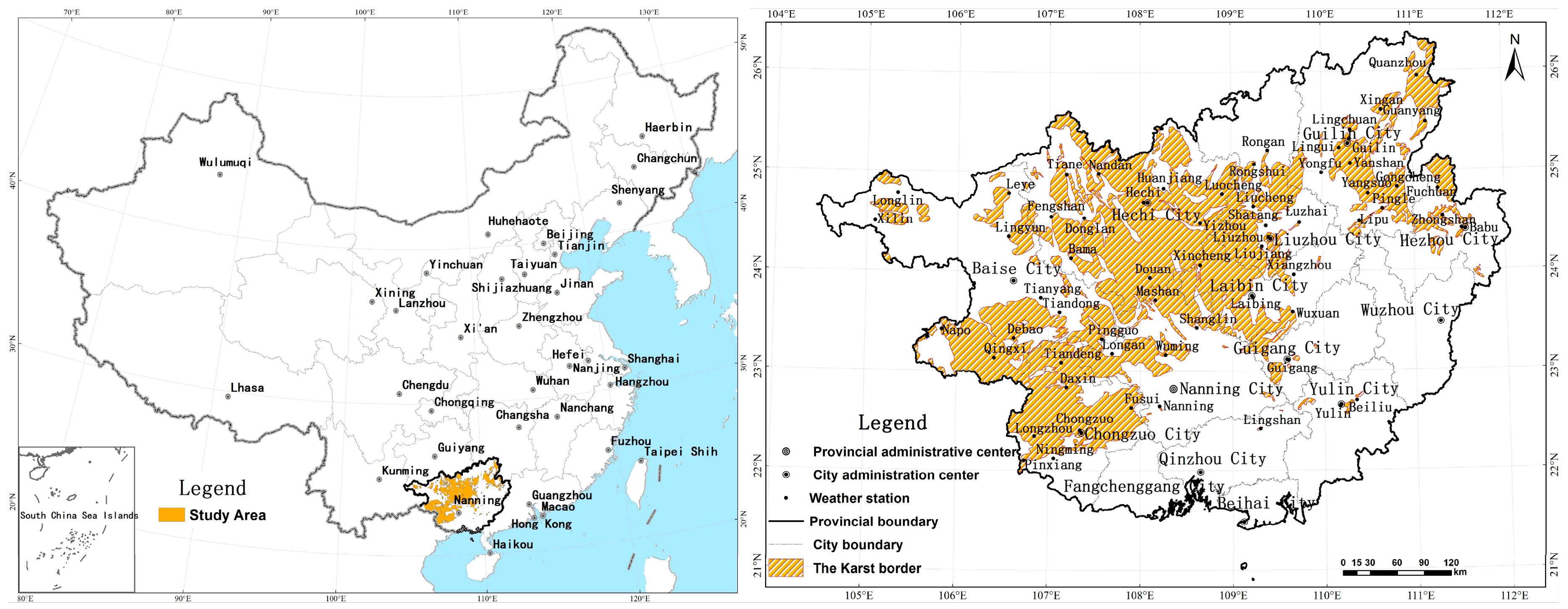
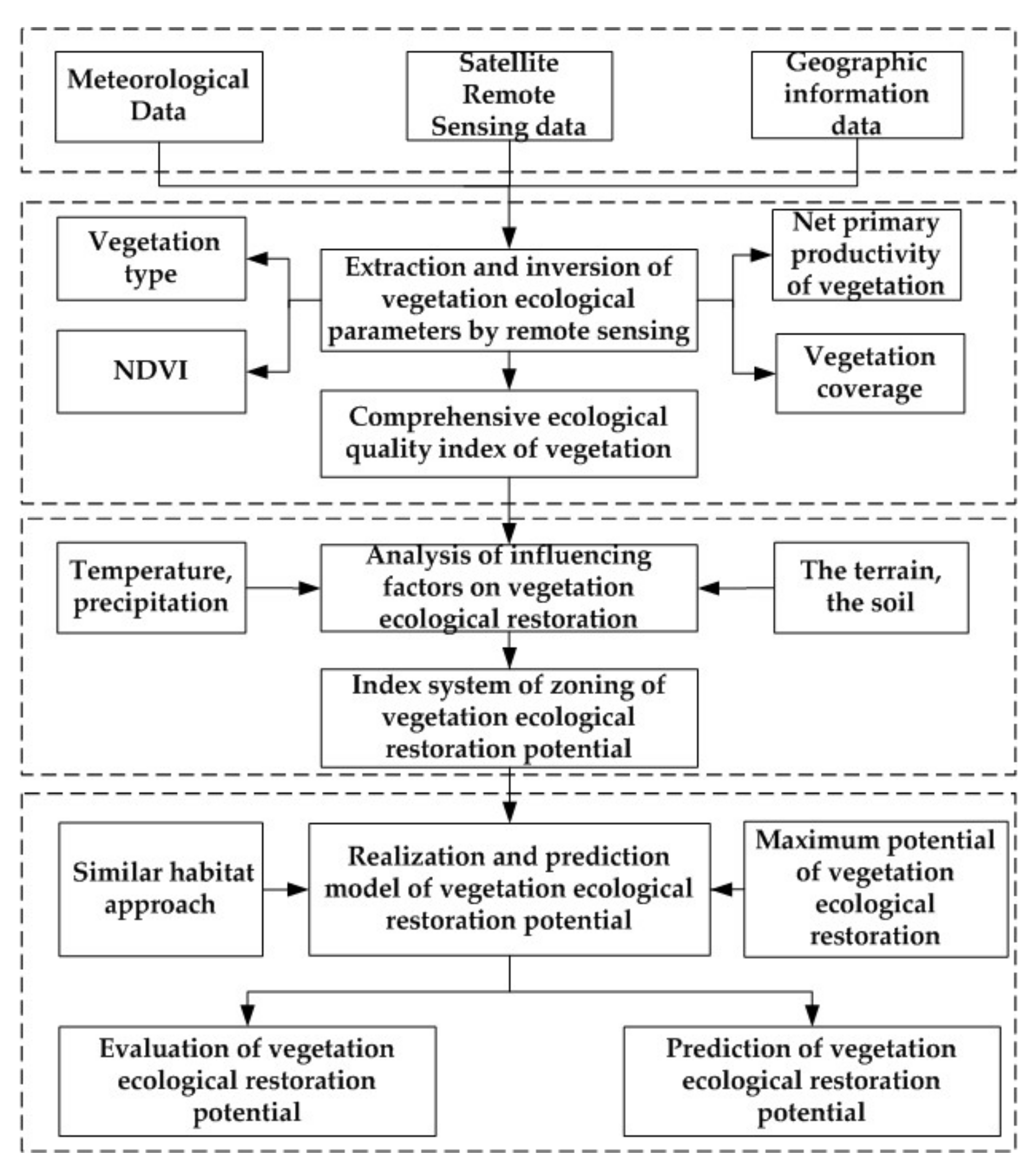
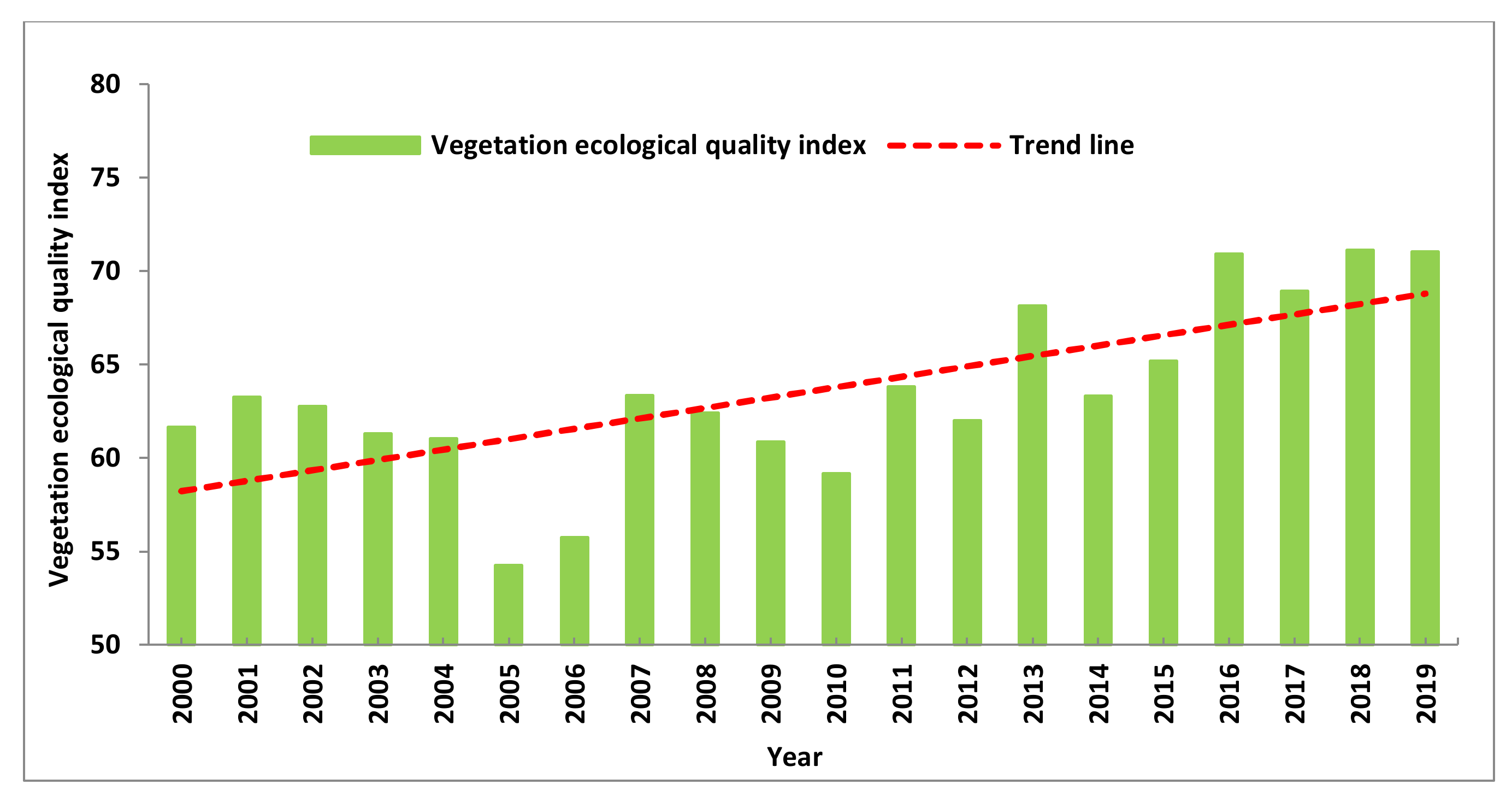


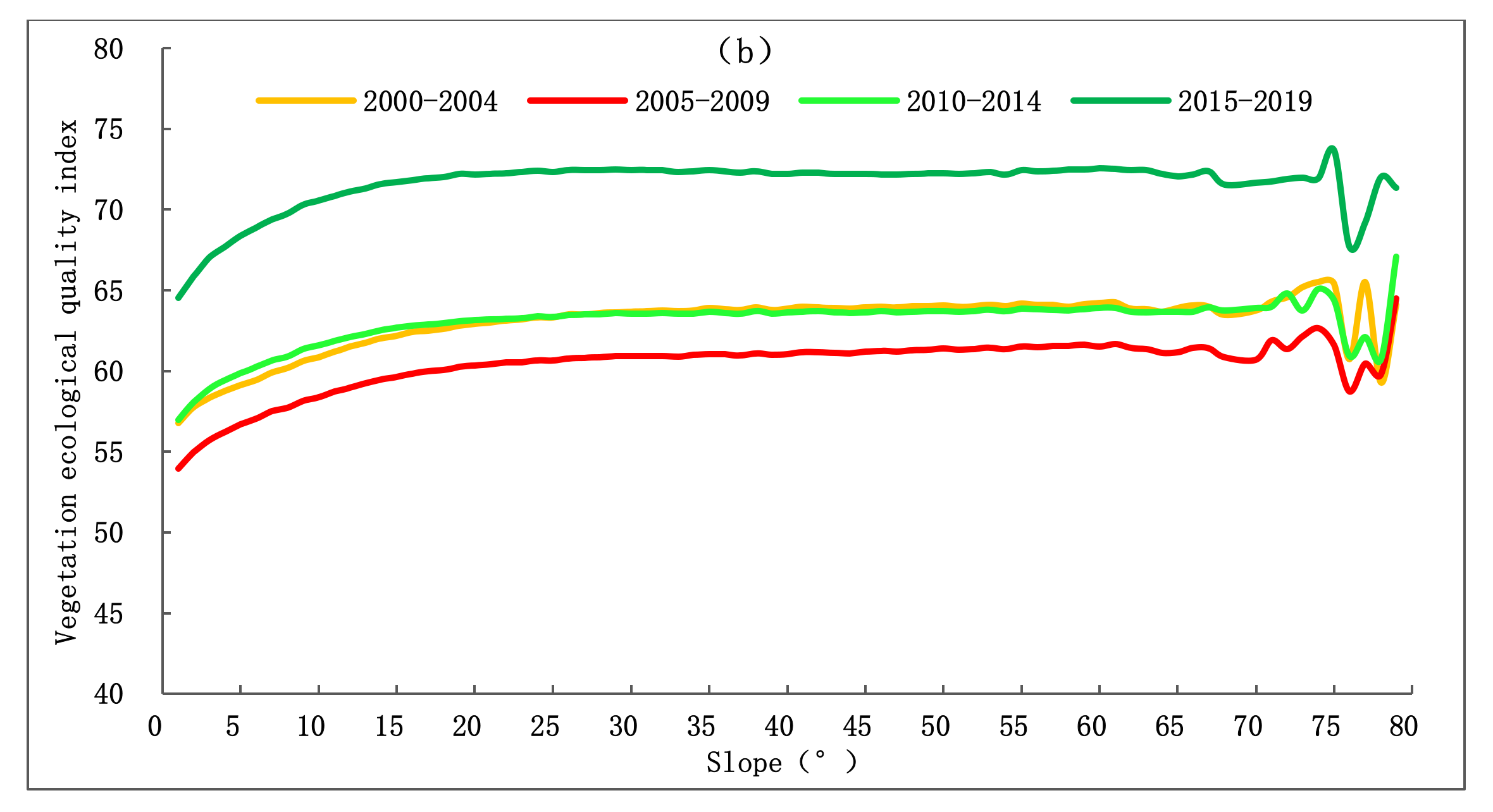

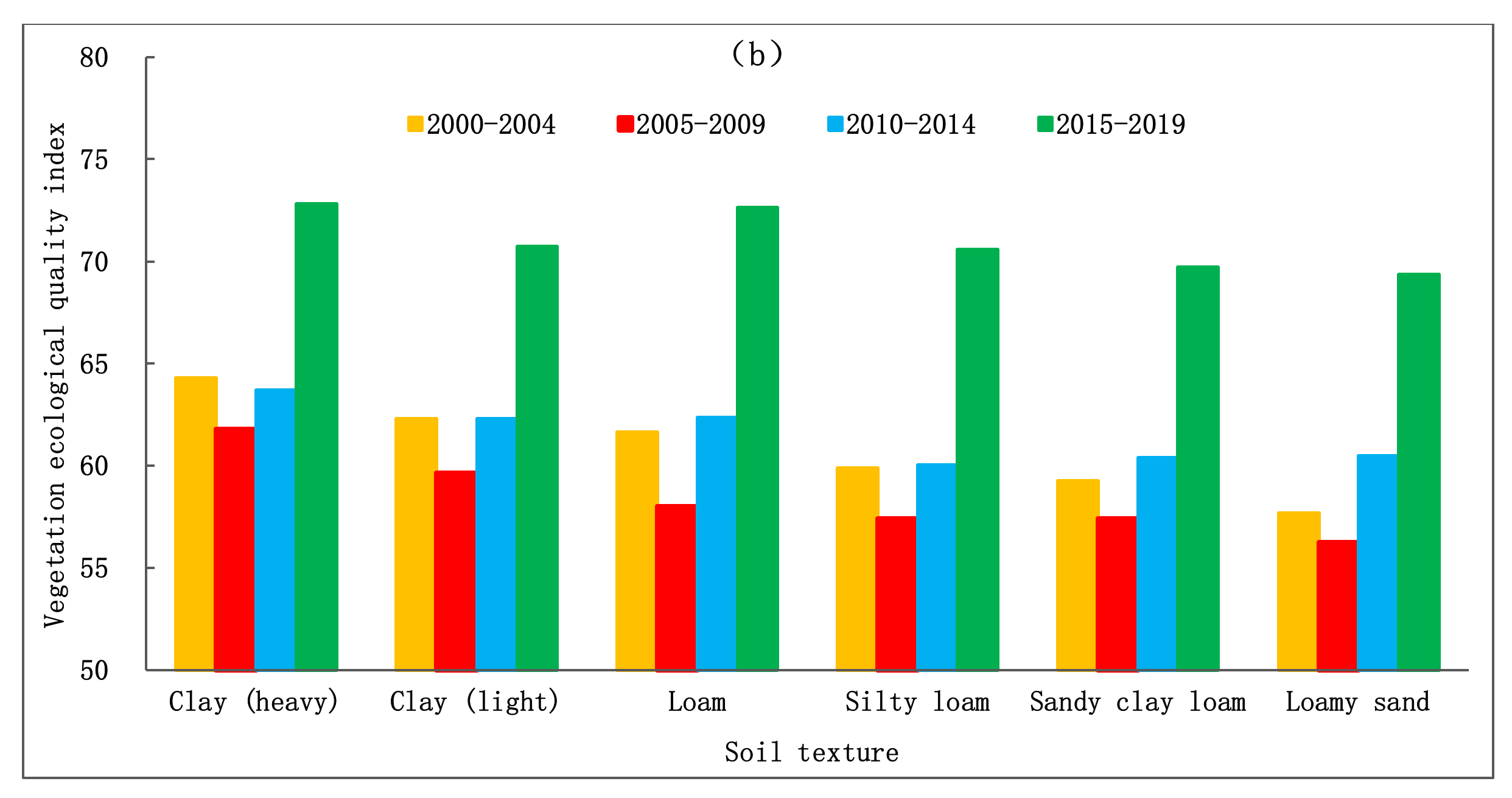
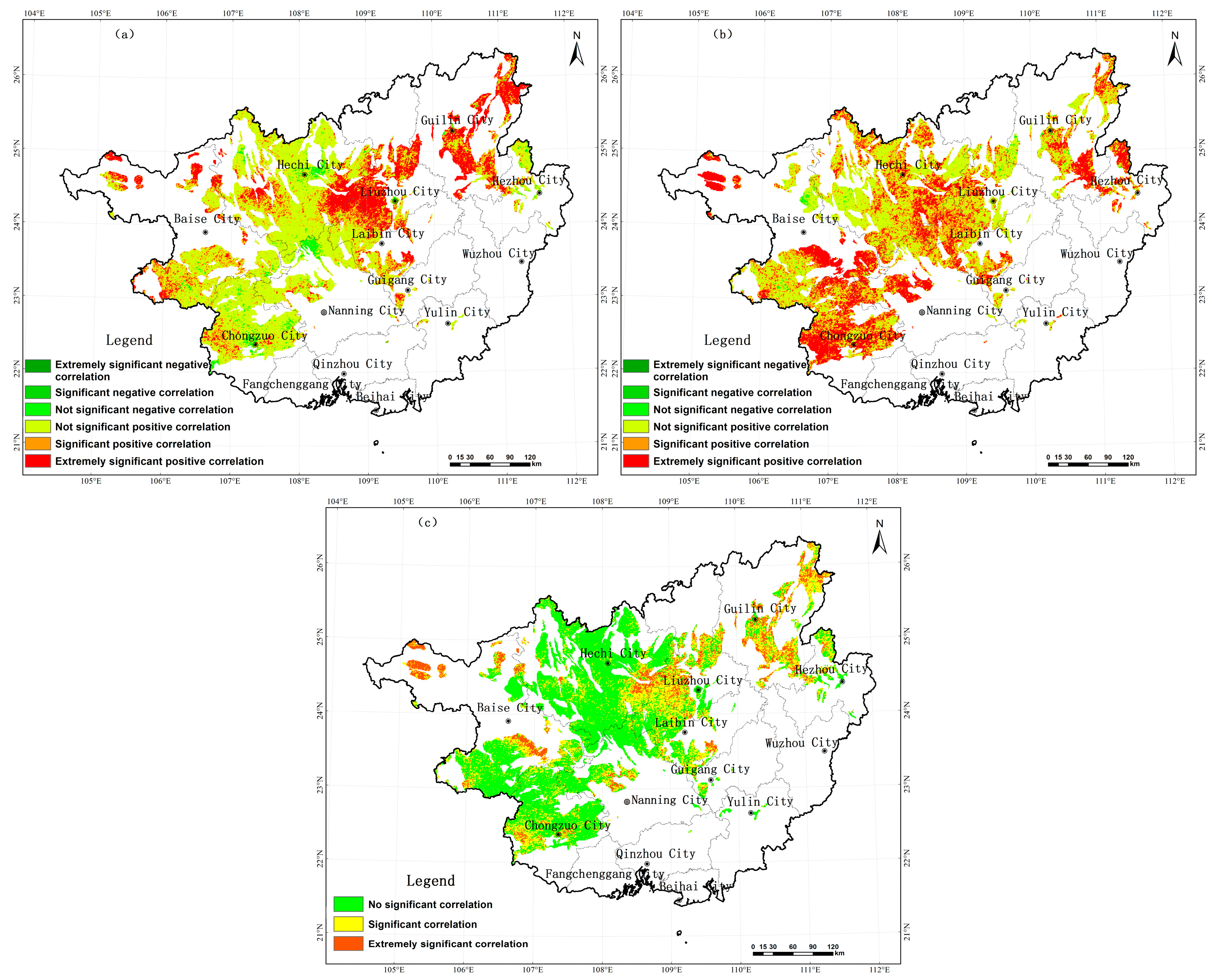
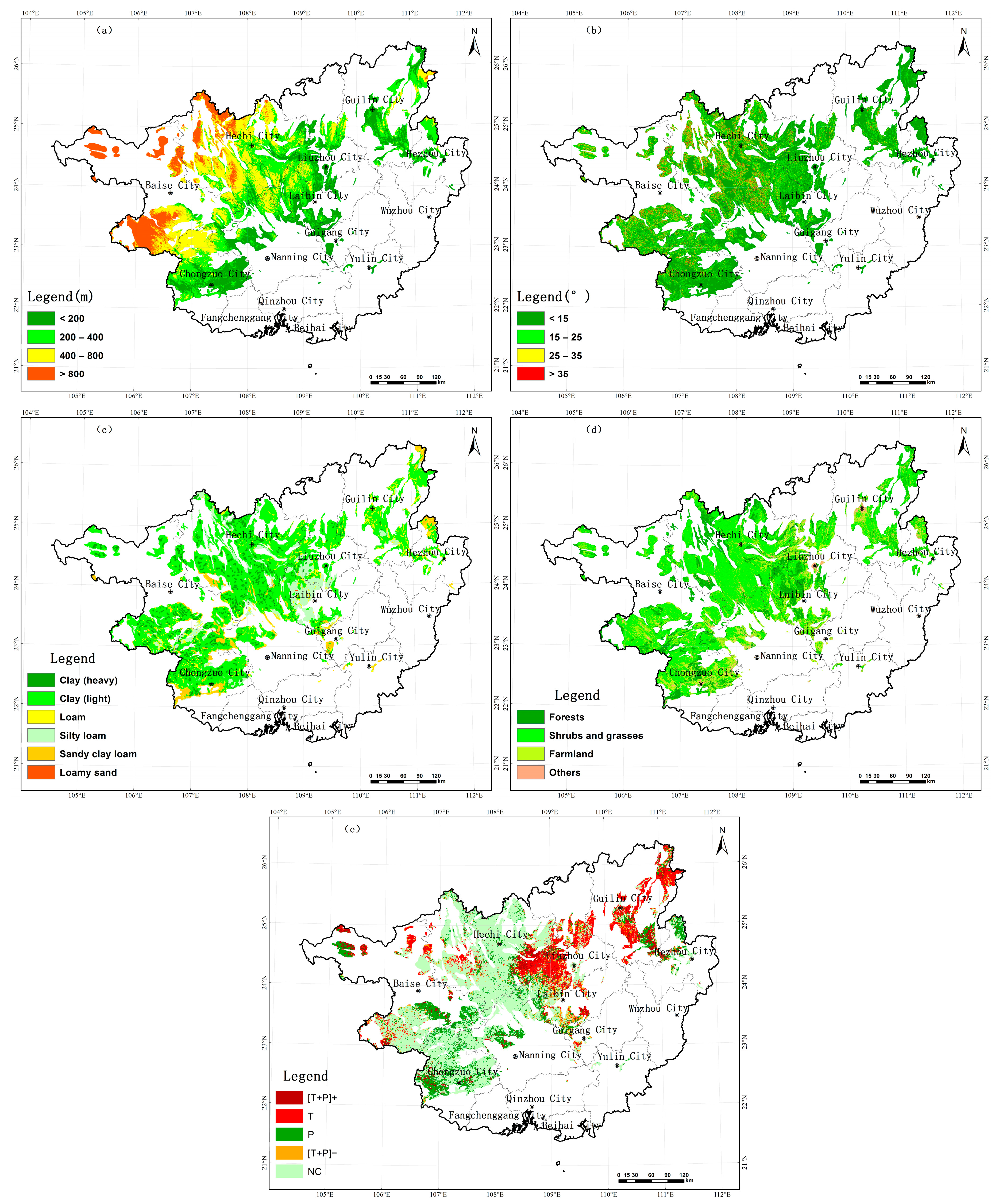

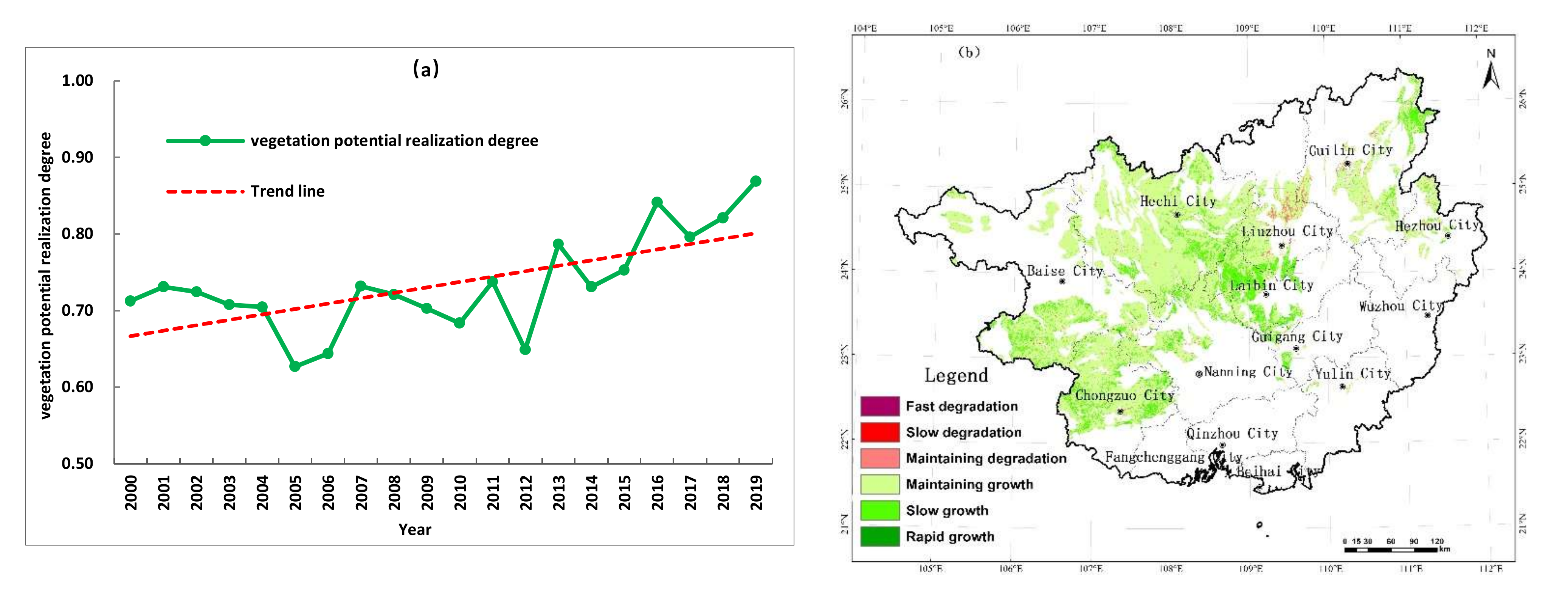
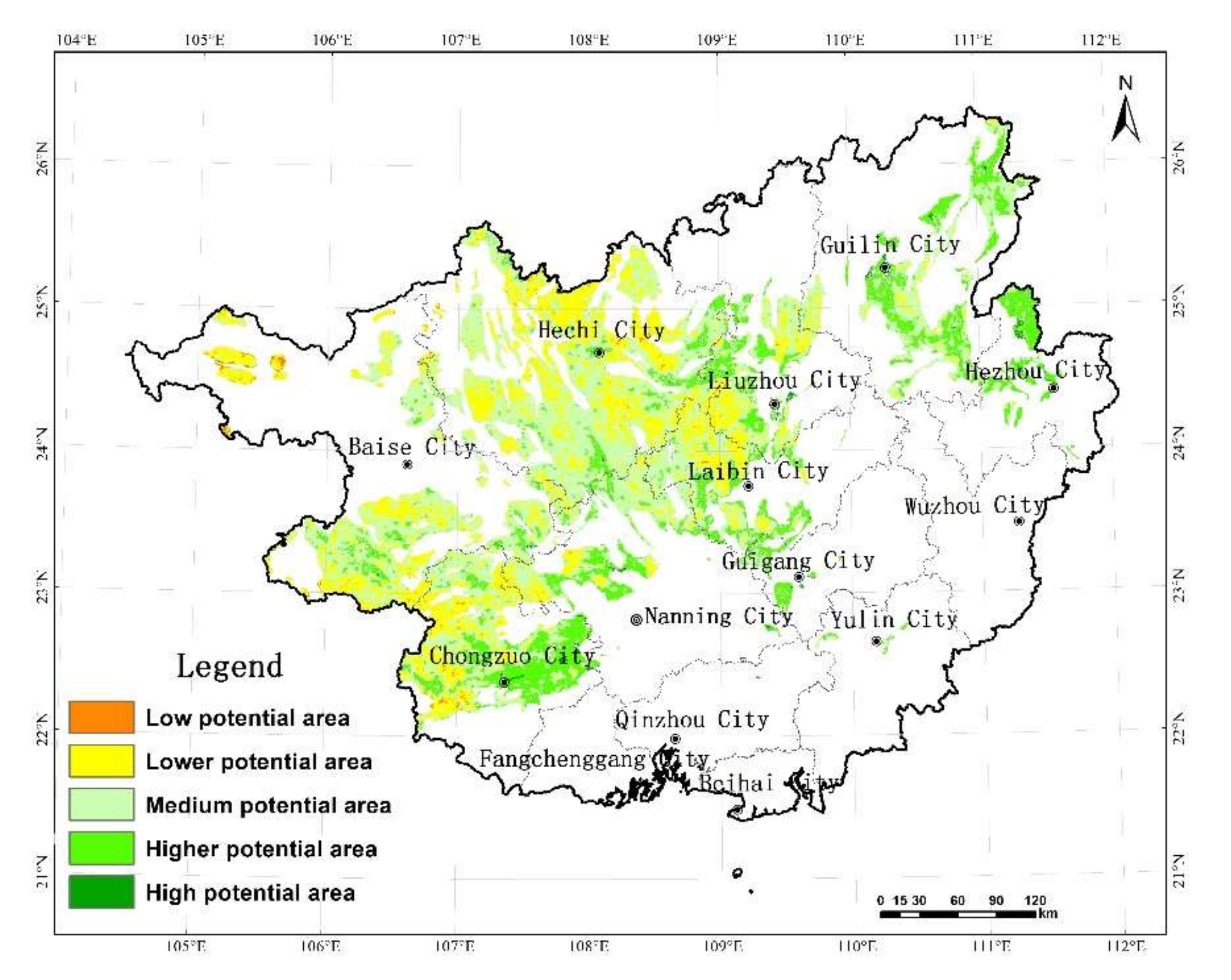
| Vegetation Ecological Quality Index | Grade | 2000–2004 | 2005–2009 | 2010–2014 | 2015–2019 | ||||
|---|---|---|---|---|---|---|---|---|---|
| Area/km2 | Proportion/% | Area/km2 | Proportion/% | Area/km2 | Proportion/% | Area/km2 | Proportion/% | ||
| <20 | Poor | 217.32 | 0.32 | 324.00 | 0.47 | 254.86 | 0.37 | 139.29 | 0.20 |
| 20–40 | Worse | 2353.64 | 3.43 | 4535.71 | 6.61 | 1709.94 | 2.49 | 493.29 | 0.72 |
| 40–60 | Normal | 22,429.71 | 32.71 | 31,385.14 | 45.77 | 20,758.29 | 30.27 | 4844.31 | 7.06 |
| 60–70 | Better | 36,439.83 | 53.14 | 29,519.90 | 43.05 | 40,829.98 | 59.54 | 28,947.34 | 42.21 |
| >70 | Good | 7136.19 | 10.40 | 2811.94 | 4.10 | 5023.63 | 7.33 | 34,152.38 | 49.80 |
| Vegetation Type | 2000–2019 | 2000–2004 | 2005–2009 | 2010–2014 | 2015–2019 | |||||
|---|---|---|---|---|---|---|---|---|---|---|
| Average | Growth Rate | Average | Growth Rate | Average | Growth Rate | Average | Growth Rate | Average | Growth Rate | |
| Forests | 73.5 | 0.8 | 70.4 | 0.8 | 71.1 | 1.2 | 73.6 | 1.1 | 80.4 | 0.8 |
| Shrubs and grasses | 71.6 | 0.8 | 68.4 | 0.3 | 69.2 | 0.7 | 71.5 | 1.3 | 78.7 | 0.6 |
| Farmland | 63.4 | 0.8 | 59.8 | 0.5 | 60.7 | 1.1 | 63.9 | 0.9 | 70.6 | 0.7 |
| Factor | Indicator | Zones | |||||
|---|---|---|---|---|---|---|---|
| Terrain conditions | Altitude | ≤200 m | 200~400 m | 400~800 m | >800 m | ||
| Slope | ≤15° | >15~25° | >25~35° | >35° | |||
| Soil conditions | Soil texture | Clay (heavy) | Clay (light) | Loam | Silty loam | Sandy clay loam | Loamy sand |
| Vegetation distribution | Vegetation type | Forests | Shrubs and grasses | Farmland vegetation | |||
| Driving factors | Climate and non-climate | [T + P]+ | T | P | [T + P]− | NC | |
| Prefecture-Level | Low-Potential Area | Lower-Potential Area | Medium-Potential Area | Higher-Potential Area | High-Potential Area | |||||
|---|---|---|---|---|---|---|---|---|---|---|
| Area/km2 | Proportion/% | Area/km2 | Proportion/% | Area/km2 | Proportion/% | Area/km2 | Proportion/% | Area/km2 | Proportion/% | |
| Guilin | 2.02 | 0.00 | 537.11 | 0.79 | 3653.24 | 5.40 | 2651.25 | 3.92 | 75.50 | 0.11 |
| Hechi | 100.99 | 0.15 | 7503.48 | 11.09 | 11,654.40 | 17.23 | 1333.81 | 1.97 | 12.71 | 0.02 |
| Hezhou | 7.49 | 0.01 | 1346.87 | 1.99 | 2353.98 | 3.48 | 1270.97 | 1.88 | 49.13 | 0.07 |
| Liuzhou | 0.00 | 0.00 | 18.72 | 0.03 | 335.69 | 0.50 | 1207.08 | 1.78 | 80.05 | 0.12 |
| Baise | 219.99 | 0.33 | 4119.93 | 6.09 | 6231.84 | 9.21 | 875.37 | 1.29 | 14.86 | 0.02 |
| Laibin | 14.64 | 0.02 | 1519.77 | 2.25 | 2774.71 | 4.10 | 1192.22 | 1.76 | 3.96 | 0.01 |
| Guigang | 9.27 | 0.01 | 1075.40 | 1.59 | 2854.20 | 4.22 | 1430.10 | 2.11 | 31.91 | 0.05 |
| Nanning | 0.07 | 0.00 | 10.67 | 0.02 | 166.01 | 0.25 | 433.76 | 0.64 | 18.71 | 0.03 |
| Chongzuo | 96.63 | 0.14 | 2960.16 | 4.38 | 4163.85 | 6.15 | 3021.74 | 4.47 | 101.21 | 0.15 |
| Yulin | 0.00 | 0.00 | 5.05 | 0.01 | 43.51 | 0.06 | 68.31 | 0.10 | 0.43 | 0.00 |
| Qinzhou | 0.00 | 0.00 | 0.00 | 0.00 | 0.00 | 0.00 | 0.93 | 0.00 | 2.42 | 0.00 |
| Total | 451.10 | 0.67 | 19,097.16 | 28.23 | 34,231.43 | 50.60 | 13,485.55 | 19.93 | 390.89 | 0.58 |
Publisher’s Note: MDPI stays neutral with regard to jurisdictional claims in published maps and institutional affiliations. |
© 2022 by the authors. Licensee MDPI, Basel, Switzerland. This article is an open access article distributed under the terms and conditions of the Creative Commons Attribution (CC BY) license (https://creativecommons.org/licenses/by/4.0/).
Share and Cite
Mo, J.; Chen, Y.; Mo, W.; Zhang, Y. Realization and Prediction of Ecological Restoration Potential of Vegetation in Karst Areas. Sustainability 2022, 14, 12525. https://doi.org/10.3390/su141912525
Mo J, Chen Y, Mo W, Zhang Y. Realization and Prediction of Ecological Restoration Potential of Vegetation in Karst Areas. Sustainability. 2022; 14(19):12525. https://doi.org/10.3390/su141912525
Chicago/Turabian StyleMo, Jianfei, Yanli Chen, Weihua Mo, and Yue Zhang. 2022. "Realization and Prediction of Ecological Restoration Potential of Vegetation in Karst Areas" Sustainability 14, no. 19: 12525. https://doi.org/10.3390/su141912525
APA StyleMo, J., Chen, Y., Mo, W., & Zhang, Y. (2022). Realization and Prediction of Ecological Restoration Potential of Vegetation in Karst Areas. Sustainability, 14(19), 12525. https://doi.org/10.3390/su141912525





